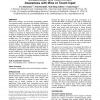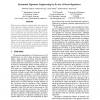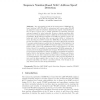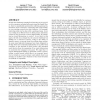282 search results - page 27 / 57 » Collaborative Intrusion Prevention |
CSCW
2008
ACM
13 years 9 months ago
2008
ACM
Multi-touch surfaces are becoming increasingly popular. An assumed benefit is that they can facilitate collaborative interactions in co-located groups. In particular, being able t...
MKWI
2008
13 years 9 months ago
2008
: Today, electronic cross-company collaboration is about to gain significant momentum, but still shows weaknesses with respect to productivity, flexibility and quality: A lack of s...
ACSAC
2008
IEEE
14 years 2 months ago
2008
IEEE
Most intrusion detection systems apply the misuse detection approach. Misuse detection compares recorded audit data with predefined patterns denoted as signatures. A signature is ...
RAID
2005
Springer
14 years 1 months ago
2005
Springer
Abstract. The exponential growth in the deployment of IEEE 802.11based wireless LAN (WLAN) in enterprises and homes makes WLAN an attractive target for attackers. Attacks that expl...
DRM
2006
Springer
13 years 11 months ago
2006
Springer
In high-tech businesses ranging from Internet service providers to e-commerce websites and music stores like Apple iTunes, there is considerable potential for collecting personal ...




